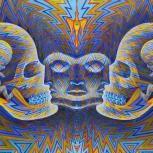-
Content count
241 -
Joined
-
Last visited
About Xonas Pitfall
-
Rank
- - -
Personal Information
-
Location
୭
- Gender
Recent Profile Visitors
-
.thumb.jpg.4c10c8590c0c29a46b5e3529f5ca992e.jpg)
Xonas Pitfall replied to mmKay's topic in Spirituality, Consciousness, Awakening, Mysticism, Meditation, God
The Ego thinks it is Love. The Dog thinks it is God! -
@Princess Arabia B=B!
-
.thumb.jpg.4c10c8590c0c29a46b5e3529f5ca992e.jpg)
Xonas Pitfall replied to Butters's topic in Society, Politics, Government, Environment, Current Events
Looks and beauty are obviously important, but if someone wants a genuine, long-lasting connection, it’s silly to make them a dealbreaker - unless you're counting on aesthetic medicine advancing drastically in the next 20 years so we can all look like youthful chickens with surgery. There has to be something "deeper" that keeps you both together, even as you wrinkle into dust. -
.thumb.jpg.4c10c8590c0c29a46b5e3529f5ca992e.jpg)
Xonas Pitfall replied to Butters's topic in Society, Politics, Government, Environment, Current Events
@Leo Gura Do you ever plan on having a long-term partner? What happens as they age? (This isn't an attack/trap question promise, just genuine curiosity - thank you!) -
@Carbon Aww, super glad it helped you! This made me smile a lot <3 I wish you the best of luck, and if you ever need help answering the questions or reflecting on them deeper, feel free to write here or DM me for support! Sorry about that. Yeah, self-esteem and confidence are probably the next areas to focus on, to be honest. If you can, investing in some sort of coaching or just putting yourself out there conversationally - or in whatever area you feel "unworthy" - is the best approach. Confidence is just massive experience. The more experience you gain in the areas where you feel insecure, the more competent you'll become, and the more self-esteem you'll rebuild. I'm sure if I asked you about your startup and had you explain it to a newbie, you'd feel plenty of assurance and confidence. To be honest, even outside of relationships, this is probably one of the most invaluable skills you can invest in. Massive opportunities open up for people just by developing more self-belief. You’re clearly a highly skilled and intelligent person - there’s no reason this has to be a lifelong struggle - I have high hopes for you, Carbon :) Good Luck!
-
Xonas Pitfall started following Wealth-Induced Anxiety
-
Hey, amazing! Congratulations! In terms of money, no one inherently "deserves" it more or less. If you look around, you'll see that a lot of resources don’t necessarily go to the most intelligent, kind, or conscious people, but rather to those who have the resources, network, grit, and perseverance to chase it. While this isn’t always the case, many people acquire wealth this way. From your perspective, you didn’t scheme, cheat, or scam - you provided something of value to society. That money is 100% deserved. In fact, there’s no one better to have it because now you’re in the best position to use it however you want and truly reflect on what will make you most fulfilled and happiest. Don’t fall into the trap of thinking, "Money won’t make things better" - of course, it will. With money, you have SO many more options: the ability to create the changes you want to see in the world, help your loved ones, push human development and research, go to therapy, and heal the parts of yourself that struggle with self-love and relationships, etc. I think this is the perfect time to reflect and ask yourself: What do you really want out of life? How much money do you need to achieve it? Looking back, what made you the happiest? What change do you wish to see in the world? What business, product, content, or creation do you want to bring into existence? What makes you enjoy your days and love your life? What inspires you? What would you need to buy or acquire to create your ideal environment? What kind of space or setting makes you feel the most inspired and at peace? What does your perfect day look like from morning to night? Who are the people you are actively engaging with daily? Who do you have around you that brings you joy, growth, and fulfillment? If you don't, where would you need to be to find such people? What kind of conversations do you want to be having regularly? What activities or work make you lose track of time? What hobbies or passions do you want to explore more deeply? How do you want to feel every day when you wake up? What kind of physical and mental routines would make you feel your best? Where do you want to spend most of your time - city, nature, by the water, in a cozy home? How much structure vs. spontaneity do you want in your days? What habits or distractions do you want to remove from your life? What experiences or adventures do you want to prioritize in your life? What is missing right now that, if added, would bring you more happiness and fulfillment? Money is an amazing tool because it gives you the freedom to pursue so much more. Not having to stress about bills or financial struggles is huge. Many people live their whole lives and die before ever having the opportunity to truly think about what they want to do in this world. Don’t feel anxious - this is an incredible moment! Your life will only get better from here. Also, what happened with your relationship, if I may ask? Is there a chance for reconciliation? If you have more time now to invest in relationships and less work stress, you could have a meaningful conversation with her about why things ended and show a real commitment to fixing things. If she was a good partner and you’re serious about making it work, I see a lot of potential there. That said, even if this relationship doesn’t work out, dating with financial stability is so much better than dating without it. In any case, it will help you find and filter out the right people - those you truly resonate with and want to spend your time with. Good luck, and once again - congratulations on your financial freedom!
-
Xonas Pitfall started following Holofractal Meta-Studies
-
Xonas Pitfall started following Beware of Charisma
-
.thumb.jpg.4c10c8590c0c29a46b5e3529f5ca992e.jpg)
Xonas Pitfall replied to Daniel Balan's topic in Society, Politics, Government, Environment, Current Events
Hugs to you! Best of Luck, @Daniel Balan <3 I believe in you. 💓💗💛💚💙💜 -
@Yimpa Oneness-One-Line-| 1 Singular Point . Back to Start, Source 10................................. .
-
Technovividtransdimensionalexisthrivehyperoblivionomniphasecosmofractalastralcyberneticholosynthpanrealismquantumpsychelexperientalogicalfluxneurocryptovortexsynchrometamorphicosmovortexhyperneuralphazionsynthorgmetapraxiexistonautxenodreamquantafluxperceptaomniphobionexpsyberrealisthastronexultrainfinitheodynam...?
-
.thumb.jpg.4c10c8590c0c29a46b5e3529f5ca992e.jpg)
Xonas Pitfall replied to stephenkettley's topic in Spirituality, Consciousness, Awakening, Mysticism, Meditation, God
@OBEler Nope, God is Everything! -
@Leo Gura Do you think you would have continued using psychedelics if there were no health issues? Do you believe psychedelics contributed to your health problems, and if so, in what way? I think an episode or even a short blog post reflecting on your personal examples of harm could be valuable for anyone getting into this space. It could also include insights on when you feel you should have stopped or taken a more cautious approach. Thank you so much, Leo! <3 Also, what are the updates on conversations with Destiny or Peter Boghossian? Cheers
-
Xonas Pitfall started following When should I get married ?
-
I think the reason there was some "outrage" is because of how you worded it. It didn't really come across as, "I feel like I found a really good partner to build my life with. I like who she is, what she stands for, and I think we'd be great long-term because we balance each other out." Instead, it sounded more like you just want to get married to feel soothed, less lonely, and less tired. That said, to answer your question - it's best to think of this as a long-term partnership, almost like a business partnership, rather than just a relationship. Ask yourself: Where are you two heading? Do you have a shared vision for the future? Do you truly understand what she needs from you and what you need from her? Can you both provide those needs for each other consistently? In a manner that doesn't exhaust either of you? Are you comfortable sharing expenses, bank accounts, structuring your life together, and making financial decisions as a team? Can you envision having children with her if that's something you want? Does she want kids? Are you aligned on parenting values and responsibilities? If she got sick or lost her looks, would you stand by her, support her, and help her through it - or would you feel tempted to cheat? Can you see yourself still feeling attraction and love for her as you both age? What would make either of you cheat, and how can you safeguard against that? How do you both handle conflict? Do you communicate well and resolve issues in a healthy way? What are her core values, and do they align with yours? Do you respect her worldview, decision-making, and approach to life? Have you discussed how you will set up your household - division of labor, roles, expectations, and responsibilities? Are you both willing to adapt, accommodate, and work through challenges as a team? Have an open, deep discussion with her about both of your life goals, how you want to build your future together, and what you both need to maintain love and commitment over the years. If most things align well and you're both willing to put in the effort, then marriage makes sense. If not, don't rush into it. This is one of the biggest decisions of your life - take the time to truly think it through. Otherwise, divorce can be a very painful experience. Good luck!
-
.thumb.jpg.4c10c8590c0c29a46b5e3529f5ca992e.jpg)
Xonas Pitfall replied to Will1125's topic in Spirituality, Consciousness, Awakening, Mysticism, Meditation, God
It implies Everything because it is Everything! 😊 -
.thumb.jpg.4c10c8590c0c29a46b5e3529f5ca992e.jpg)
Xonas Pitfall replied to Daniel Balan's topic in Society, Politics, Government, Environment, Current Events
You can watch those 1vs25+ Jubilee politics debates and just notice - who are the people that seem the smartest to you? The most composed and genuine? With most people, you'll see their arguments crash and burn so fast that they immediately start attacking the other party, getting upset, or resorting to some insane personal anecdote with no real evidence. "You are attacking me because I am black! Stop that!" "You just wanna fight - you think I'm stupid because I'm a woman, don't you?" "Wow... solid point, bro - but you have crooked teeth and a lisp, so I don't wanna listen to you." I'm not even exaggerating - some people genuinely bring up this kind of stuff in arguments. You'll see that most people have zero clue what their values are, why they think what they think, and they just want to conform to some status quo or "trendy" way of thinking. If you don’t take independent thinking seriously, you will end up with something close to that. -
.thumb.jpg.4c10c8590c0c29a46b5e3529f5ca992e.jpg)
Xonas Pitfall replied to Daniel Balan's topic in Society, Politics, Government, Environment, Current Events
@Daniel Balan One of the best tips is to just ask "Why?" after any assumption or judgment you make. The most independent-thinking and clear-minded people - the least easily persuaded and manipulated - can answer an infinite number of "And why is that?" questions. You can keep probing them forever, and their answer will never be, "Oh because this person told me!" or "Because the Bible says it's true!" With most people, though, this won't be the case. If you "probe" enough, they will eventually get overly defensive, emotional, or mad at you. If you can state a value or opinion you hold, and I can ask you 7+ "Why?" questions - Why do you care about this? Why do you think this and not that? Why does it matter to you? - and you can stand firm in your reasoning, it's a good sign you might be solid in your understanding and less easily persuaded. A good way to practice this is to take your father's beliefs and ask yourself: Why is this belief good to have? Why is it bad? Keep asking yourself that until you arrive at the final answer. In the end, most answers will fall into one of three categories: A) I don't know. (This is fine, most people won't even admit this. Not-knowing is a good spot to be in, counter to popular belief.) B) Because someone I think is smart believes it. Then ask: Why do I think this person is smart? Why do I respect their opinion? If your answer is, "Because they seem smart," that's bad. If it's, "Because they are fun, charismatic, or seem to have their life together," This is also bad. If your answer is, "Because they hold values I also think are important," then that's good. See how it loops back to you? "I think these values are important, and this person aligns with them, so I will listen to them." The authority of your mind stays with you, not others. "If I ever stop thinking this is a good value, I will stop listening to them." C) Because I think this is fundamentally right and good. Why? If your answer includes personal experience, direct experience, or logical deduction, this is also good. TL;DR: You don't want to be the person who says, "I believe it because my teacher told me," "I believe it because the Bible says so," "I believe it because my dad says so and he's cool," or "I believe it because a bald guy on a podcast says it, and he has money, women, and status, so I respect that." There are still plenty of slippery slopes you could fall into, but this is a good start. Make sure you can go down a chain of several "Why?" questions without contradicting yourself, without referencing someone else's value system, and without getting upset or using broken logic. If you can do that, you're already in a better place than before. If you keep this mindset throughout your life, you'll be much less likely to be scammed or easily persuaded.💛







